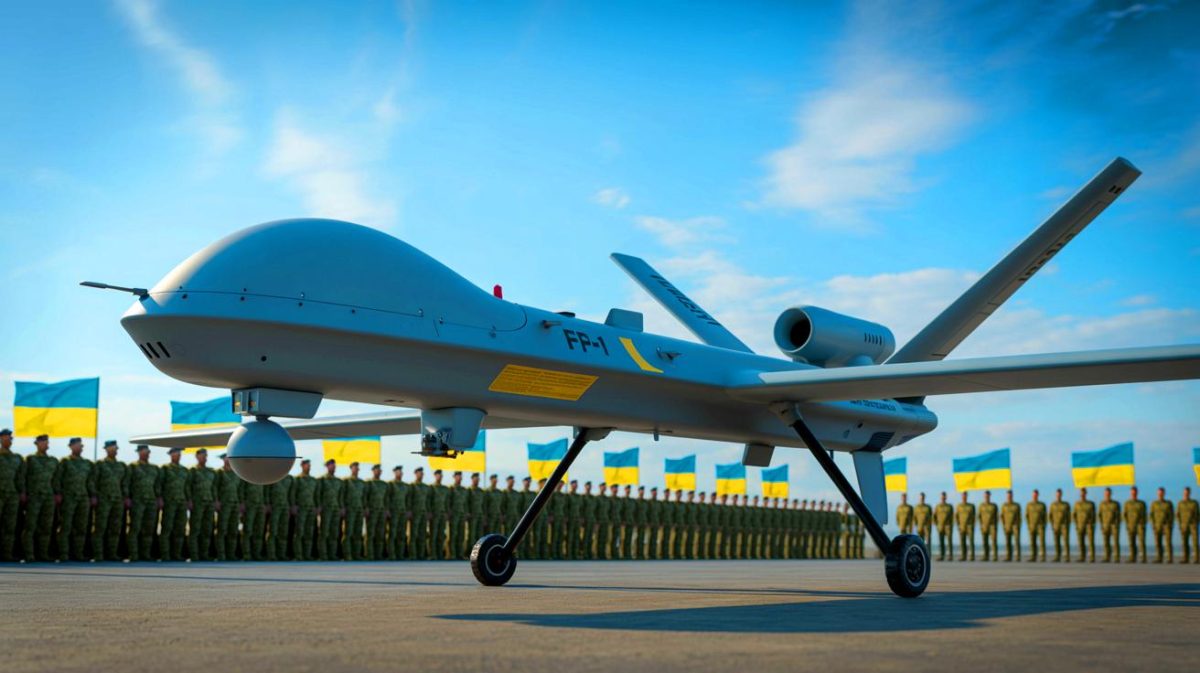| IN A NUTSHELL |
|
In a significant development in military technology, Ukraine has introduced a groundbreaking long-range drone, the FP-1, which was unveiled during Infantry Day commemorations on May 6, 2025. This drone, capable of reaching targets up to 1,000 miles away, marks a pivotal advancement in Ukraine’s defense capabilities. Designed to engage high-value strategic targets, the FP-1 represents a critical component of Ukraine’s military strategy, especially in the context of ongoing conflicts. With its ability to carry a substantial payload, this drone is set to redefine the landscape of modern warfare.
The FP-1: A New Era in Long-Range Strike Drones
The FP-1 is a testament to Ukraine’s rapid advancement in drone technology, designed specifically for long-range strike operations. With a remarkable operational range of 1,000 miles, this drone is engineered to deliver a substantial warhead payload of up to 265 pounds. According to Deputy Minister of Strategic Industries Anna Hvozdiar, the FP-1 is already in serial production, emphasizing its readiness and operational potential. This shift in drone capabilities is part of Ukraine’s broader defense strategy, aiming to produce at least 30,000 long-range drones within one fiscal year, as announced by President Volodymyr Zelensky in 2024.
The FP-1 serves as a strategic response to the threats posed by the Russian Federation’s deep rear staging areas and logistics hubs. By extending its reach, the FP-1 effectively brings critical Russian infrastructure, including assets in Crimea and occupied regions, within striking distance. This development is a clear indication of Ukraine’s evolving military doctrine and its reliance on advanced drone technology to counter asymmetric warfare challenges.
Ukraine’s Strategic Advantage with the FP-1
One of the most significant aspects of the FP-1 is its modular design, which likely incorporates commercially available parts. This makes the drone not only cost-effective but also adaptable for a variety of military operations. Analysts believe that the FP-1 may feature advanced technologies such as terrain-following navigation, GNSS-denied capability, and encrypted telemetry. These features are crucial for evading sophisticated Russian air defense systems, including the S-300/400 and electronic warfare jammers.
Since late 2022, Ukraine has embraced a doctrine of distributed drone warfare, which has become a cornerstone of its defense-industrial policy. The country’s Ministry of Digital Transformation has actively supported private-sector drone developers, fostering innovation and integration of unmanned systems. With successful strikes reported in regions as far-reaching as Tatarstan, the FP-1 is not merely another drone but a strategic asset that enhances national defense resilience and force multiplication.
The Impact of the FP-1 on Modern Warfare
As Ukraine’s conflict enters its third year, the deployment of deep-strike UAVs like the FP-1 is reshaping the tempo and geography of the conflict. These drones challenge traditional notions of strategic sanctuary and underscore the evolving nature of warfare. The FP-1’s presence marks a shift in how military power is projected, with drones now playing a central role in strategic deterrence and operational effectiveness.
The FP-1’s ability to operate at long ranges and deliver precision strikes makes it a formidable tool in Ukraine’s arsenal. By targeting critical infrastructure and logistics lines, the FP-1 disrupts enemy operations and creates strategic advantages. This shift highlights the increasing importance of unmanned systems in modern military strategies, where agility, precision, and reach are paramount.
Future Prospects and Challenges
Looking ahead, the FP-1 represents both an opportunity and a challenge for Ukraine. While it offers significant strategic advantages, the continued development and integration of such advanced systems require sustained investment and innovation. As Ukraine refines its drone capabilities, questions remain about how these technologies will influence the broader dynamics of the conflict and international military strategies.
Moreover, as other nations observe Ukraine’s advancements, the global landscape of drone warfare is likely to evolve. The FP-1 serves as a model for how countries can leverage unmanned systems to enhance their defense capabilities. How will the international community respond to the proliferation of such technologies, and what implications will this have for global security?
The unveiling of the FP-1 marks a pivotal moment in Ukraine’s defense strategy and the broader realm of military technology. As this drone takes to the skies, it raises questions about the future of warfare and the role of unmanned systems in shaping global security dynamics. How will other nations adapt to these advancements, and what new challenges will emerge in this evolving landscape?
Did you like it? 4.5/5 (28)









Wow, 1,000 miles? That’s some impressive range! 🚀
Est-ce que d’autres pays suivent cet exemple en développant des drones similaires ? 🤔
La modularité du design de ce drone est vraiment une idée géniale. 👏
265 pounds d’explosif, c’est énorme ! Est-ce que c’est vraiment sûr ?
Merci pour cet article très informatif sur le FP-1 !
Je me demande si ces drones pourraient un jour être utilisés à des fins civiles. 🤖
C’est comme un épisode de Black Mirror en vrai, non ? 😅
How much does each FP-1 drone cost to produce?
Est-ce que cela signifie la fin des batailles traditionnelles au sol ?